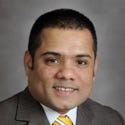The 'Rock Star' Government CIO, RedefinedThe 'Rock Star' Government CIO, Redefined
Relationships matter for CIOs who must navigate politics and bureaucracy to assert authority over a centralized, coordinated IT strategy.
September 23, 2014

Having a "rock star CIO" -- or better yet, being anointed one -- is heady.
Vivek Kundra is one such CIO. After unquestioned success as chief technology officer (CTO) for the District of Columbia, where he implemented cloud computing and crowdsourced applications development, he was tapped to become the first federal CIO. Kundra himself used the term "rock star CIO" in suggesting what federal agencies needed to move the federal government from 1960s era technology to 21st century technology.
However, rock star CIOs who have moved from the private sector to the public sector are often unaccustomed to dealing with a multitude of public sector stakeholders where profit maximization is not the focus. These transplanted CIOs often have a much different attitude towards risk tolerance and preferences. Private sector CIOs are seldom used to dealing with the funding issues associated with continuing to run an aging infrastructure while trying to innovate.
[Pooling of resources: Federal Shared Services Gains Traction.]
One thing is becoming clear about all public sector CIOs, whether they are rock stars or not: Relationships are far more important than rock star status.
Many state-level CIOs lack a direct reporting relationship with the governor and need to work through traditional bureaucracies to make things happen. Thus, for example, within the State of California, an innovative idea that is sparked or suggested by the state CIO must be embraced and forwarded by the business unit (an agency within the state government), funded by the legislature/governor, blessed by the Department of Finance, and procured by the Department of General Services.
This is why relationships matter. The CIO, far from a solitary figure on stage, needs to have a close relationship with both the governor and the state legislature to truly make things happen.
Consider the case of Michigan, where a strong relationship between Michigan CIO David Behen and Gov. Rick Snyder has led to several innovations within the state. Gov. Snyder, the former chairman of Gateway Inc., appreciates the value of having a robust IT infrastructure. He has collaborated actively with CIO Behen on several flagship technology efforts. For instance, in 2012, Michigan developed a $2.5 million innovation fund that invested in innovative technology collaborations between state and local government, with the intent of bringing forth technology projects that probably wouldn't happen otherwise. In addition, the governor allocated millions of dollars to new IT upgrades designed to innovate in areas of cost control and service delivery to citizens, such as a Medicaid Management Information System and an upgraded cyber command center developed to respond to emergencies.
Florida is the only state government in the US without a CIO. Florida has gone through several IT transitions over the years without CIO leadership, and the state legislature is largely in charge of the state's IT management. The legislature established the Agency for Enterprise Information Technology in 2007 but tried to abolish it in 2012. While the governor saved the agency from elimination, it has no budget or staff. As a result, each department generally fends for itself, and any incoming CIO will need to deal with a legislature that tried to abolish it, a governor that won't fund it, and individual departments with technology fiefdoms; a daunting challenge for any CIO.
Our recent research turned up another interesting finding about the relationship between centralized IT under a strong CIO versus a decentralized approach. Logically, any CIO -- but particularly a rock star CIO -- would favor centralized governance. After all, centralized governance would give the CIO much greater ability to implement IT since it would provide greater control over budgets, personnel, strategy setting, and, ultimately, performance.
Decentralization has always been popular. From political thinker and historian Alexis de Tocqueville (1805-1859), who advocated for decentralization of government; to noted futurist John Naisbitt, who identified decentralization as a top 10 megatrend shaping people's lives in 1982 bestseller Megatrends; to the Reinventing Government movement of the 1990s that pushed decentralization as the key to effective government, leading thinkers have long advocated decentralization as the key to effective performance. In many ways, decentralization is seen as the evolved response to the problems of centralized governance and is believed to improve efficiency, enhance organizational performance, provide faster reactions to problems, and improve service delivery.
In our most recent research, "An Argument for Centralization of IT Governance in the Public Sector," to be presented at the upcoming Hawaii International Conference on Systems Sciences (HICSS), we sought to investigate whether this held true for state-level IT governance. Our research looked at four major governance tasks -- strategy setting, finance, personnel, and coordination/planning -- at each of the states and used data from the Center for Digital Government (CDG) and the National Association of State CIOs (NASCIO) for our analysis.
Using a qualitative comparative analysis (QCA), which is a set-theoretic approach that combines qualitative (case-based) and quantitative (variable-oriented) techniques, we were able to identify the level of centralization of each task for each of the US states. Not surprisingly, we found great variation across the states in terms of their centralization for each task
However, the results were unmistakable: Centralization wins in a rout.
While the level of centralization for finance and coordination were unimportant, centralized strategy setting and centralized personnel actions were firmly linked with better performance. Our results suggest two things. First, it validates the importance of a strong central CIO and suggests that any attempts to weaken the position are misguided. Second, it confirms that the CIO needs to focus on setting the overall strategies, but also needs to be able to pick the people to implement the overall strategy. By leading from the front, a strong, centralized CIO is best positioned to lead the organization's IT function.
Based on all of this, we propose to redefine the notion of a rock star CIO to one that is closely aligned with the governor and the legislature and, likely as a result of this closeness, has centralized key strategy and personnel responsibilities to reflect that alignment. The CIO, and by extension the organization, is only capable of performing well with power to define the IT strategy, the people to enact it, and the relationships to enforce it. Anything short of this simply creates a poor shadow of a rock star.
Our new survey shows fed agencies focusing more on security, as they should, but they're still behind the times with cloud and overall innovation. Get the new IT Priorities In Order? issue of information Government today.

Gregory Dawson
Gregory S. Dawson is an Assistant Professor in the Information Systems Department at the W.P. Carey School of Business and is also a Research Fellow at the Center for Organization Research and Design, both at Arizona State University. A former Partner with the PricewaterhouseCoopers (PwC) government consulting practice and former Director at Gartner Consulting's state and local government practice, his most recent series of reports examines innovation in the public sector. He can be reached via [email protected]
James S. Denford serves as the Department Head of Management & Economics and is an Assistant Professor at the Royal Military College of Canada. A former senior officer in the Canadian Army, his most recent series of reports examines public sector Information Technology leadership and governance. He can be reached via [email protected].
About the Author
You May Also Like






